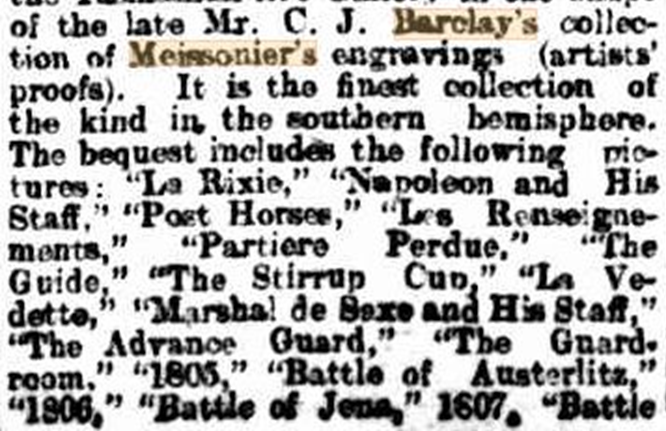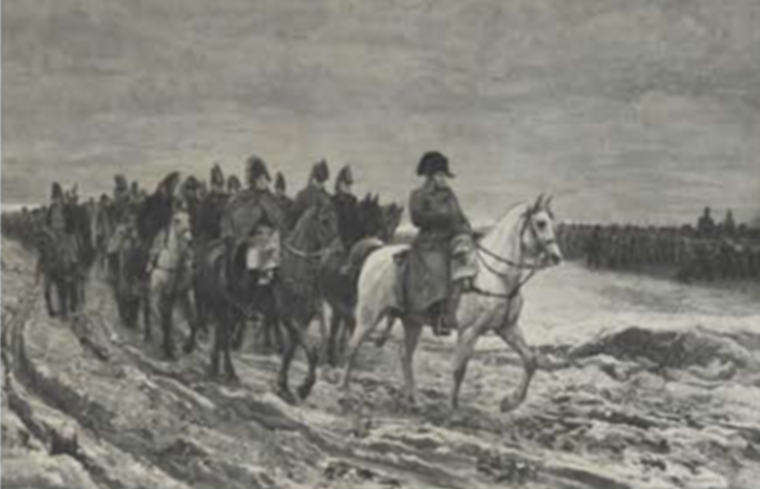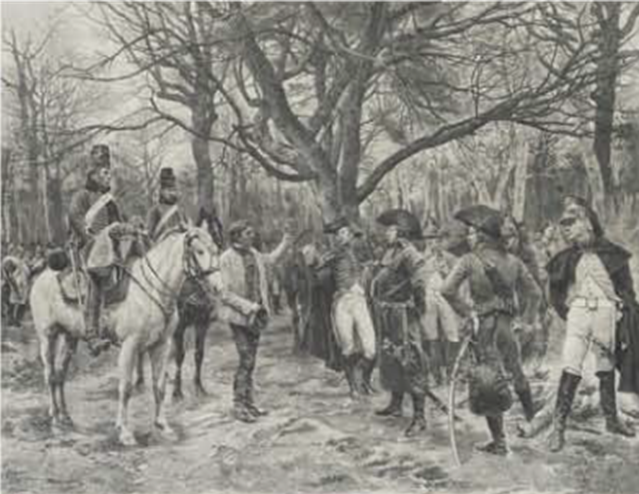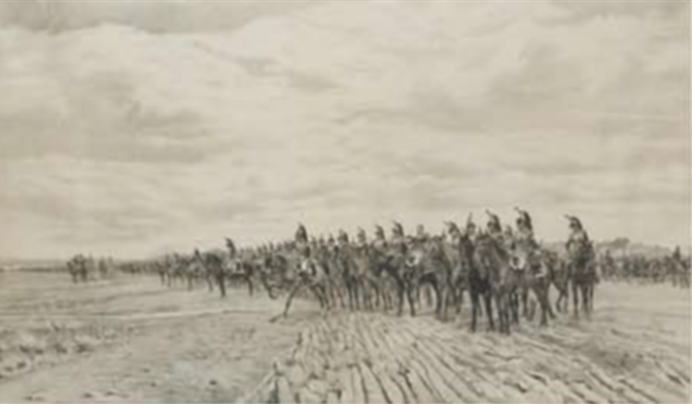Stories from the Royal Society of Tasmania Art Collection
13. The Meissonier etchings
Article prepared by the RST Honorary Curator, Dr Anita Hansen, for the April-May 2023 RST Newsletter.
I thought that I would write about something quite different for this month’s newsletter. That is, artworks that are not by a Tasmanian artist or of a Tasmanian scene or person.
There has been some debate as to whether artworks not related to Tasmania should be in the collection.
The Bequest
In the Royal Society of Tasmania Art Collection there are presently fifteen etchings after Jean Louis Meissonier. I say presently, because there were eighteen etchings in the bequest, however three are now missing.
The works were bequeathed to the Society by Charles Barclay in July 1904. Mr Barclay was a long-time member and Council Member of the Royal Society of Tasmania, joining the Society in 1873.

bequest by Charles Barclay – 1904.
Dear Sir,
I have pleasure in advising you the Royal Society is to receive
under Mr Barclay’s will all the prints after Meissonier …
This was a very important gift. The Mercury reported at the time; ‘It is the finest collection of the kind in the Southern Hemisphere …”

Charles Barclay
Charles James Barclay (1841–1904), bank director, was born on 27 January 1841 at Glenorchy, near Hobart Town, son of David Barclay, a watch and instrument maker who arrived at Hobart in the Resource in 1830, and his wife Margaret, née Strachan.
Barclay had many interests. He was a justice of the peace from 22 April 1870 until his death. On 10 June 1873 he was elected a fellow of the Royal Society of Tasmania, in June 1899 became a member of its council and bequeathed to it his collection of prints or engravings copied from the paintings of the artist Jean-Louis-Ernest Meissonier (1815–1891). In 1880 he became a member of the general committee of the Hobart Savings Bank, founded in 1845 by George Washington Walker, and in 1894–1904 served zealously as its president. In 1887 when an Act of parliament established the Perpetual Trustees, Executors and Agency Co. of Tasmania Barclay became its first chairman, an office he retained until 1904. In 1871 he was vice-president of the Tasmanian Club and in 1901-04 its president. On 24 March 1903 the Hobart City Council appointed him a trustee of the Tasmanian Public Library and four months later he was elected chairman of trustees. The Art Society of Tasmania, of which he was sometime vice-patron, found in him a good friend, ever ready to assist in its endeavours to promote interest in the skills it fostered. By his quiet unostentatious ways and thoughtful kindness he won gratitude and much respect. He died at his home, the Bank House in Macquarie Street, on 14 June 1904 and was buried at Cornelian Bay. He left no family. On 18 August 1885 he had married Margaret Birkmyre Pringle; she died on 4 May 1922.
[Australian Dictionary of Biography (anu.edu.au), viewed 5/05/2023.]
The Etchings
All but one of the etchings were mounted in elaborate golden frames, and when seen as a group are truly breathtaking.

in elaborate golden frame.
They are quite large images, each approximately 37 x 55.5 cm, and of course, much larger when mounted and framed.
The Society’s prints are engraving proofs from the mid-late 1800s. Interestingly, they are printed on faux vellum.
Faux or Imitation Vellum
A thick, ivory-coloured paper originally treated and embossed to simulate the appearance and texture of animal Vellum. First made in the late 19th century, vegetable vellum is a tough, translucent paper made from chemical wood pulp and/or cotton fibres. The fibre sheet is coated or impregnated to produce a semitransparent paper with low gloss.
What does ‘after Meissonier’ mean?
The Society’s artworks are identified as ‘after Meissonier’. An ‘after’ print, refers to a print that is made by an artist based on an original painting or a work by a different artist. For example, an etcher could make an etching based on a painting by Meissonier, and the resulting print would be ‘after’ Meissonier.
In the case of the Meissonier etchings, a number of etchers were involved; the most famous was Jules Jacquet, however his brother, Archile Jacquet, as well as L. Monzies and A. Lamotte are also featured in the Society’s collection.
Jean-Louis-Ernest Meissonier (1815-1891)
Meissonier was a recognized power in the art world. He had served on Salon and Universal Exposition juries, been elected to the Académie des Beaux-Arts in 1861, served as president of the Institut de France and later of the Société Nationale des Beaux-Arts, and received an elaborate academicians’ funeral at the Madeleine in Paris.
At an early age Meissonier moved from Lyons, where he was born in 1815, to Paris. With his father’s support he chose a career in the arts. As well as painting, Meissonier studied engraving and aquatint. By the mid-1830s, he earned a good livelihood as a book illustrator with Tony Johannot.
Influenced by seventeenth-century Northern genre and contemporary historical genre painting, he began painting small-scale scenes of typical life set in the seventeenth and eighteenth centuries.
Meissonier determined to become the modern van der Meulen (Adam Frans van der Meulen, the prestigious military painter to Louis XIV), and shifted from historical genre to images of modern warfare and military life as both ‘high’ history painting and genre. His passion for military affairs culminated, in 1859, in an imperial commission for an illustrated book on the current Solferino campaign, with a text by Edmond Texier of Le Siècle. His representation of contemporary military subjects expanded to include earlier Napoleonic subjects. Meissonier’s career prospered despite the fall of his imperial patron in 1870. He pursued the Napoleonic imagery in part to remind his compatriots of France’s proven military glory. Such works were nonetheless in great demand abroad as well. By the time of his death in 1891, Meissonier’s paintings and prints could be found throughout Europe, the United States and even as far away as Tasmania. Some of Meissonier’s best works were towards the end of his life and were quite epic in their proportions and detail.
[https://www.wokinghampaper.co.uk/every-picture-tells-a-story-a-special-french-engraving/. Viewed 15/06/2020]

oil on wood by Ernest Meissonier, 1864; in the Orsay Museum, Paris.

Royal Society of Tasmania Art Collection.
Jules Jacquet was born in Paris in 1841. He was a keen artist from a very early age and was encouraged along with his brother, Achille, to practice their art at every opportunity. His parents sent him off to study under Henriquel-Dupont, a fine artist and engraver himself who was recognised in France as one of the best tutors of engraving. Both Jules and Achille became renowned engravers with Jules surpassing his brothers’ skills. At the age of only 25, in 1866, Jules won the Prix de Rome, which brought him enough notoriety to be able to concentrate on his art for the rest of his life. He formed a liking for Meissonier’s work most of which depicted the wars and battles of Napoleon his armies and his soldiers keeping themselves amused in between battles.
[This is the artist’s biography published in the NGA Systematic Catalogue]
In comparing the two images, one can’t help but be astonished by the masterful etching skills demonstrated by Jacquet.
Napoleonic Etchings
I can’t show you all the etchings in this article – there are, after all, fifteen of them. For this article I will concentrate on the etchings depicting scenes of Napoleon and his battles. Unfortunately, we don’t yet have high resolution digital copies of these etchings.
I have included the titles that have been given to these etchings in the past. I have done some research on these and found that there are several different titles given to the same artwork on various sites. It will take a bit of unravelling to sort this out.
An example of this is the etching title The Lost Game in our records, however, when I found the original oil painting by Meissonier, it was titled Campaign of France, 1814.






The Royal Society of Tasmania’s Art Collection is housed at the Tasmanian Museum and Art Gallery, Hobart.
Any queries, please contact the Honorary Curator, Dr Anita Hansen: anita.hansen@utas.edu.au
